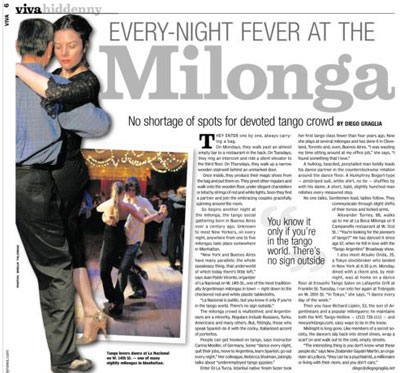 They enter one by one, always carrying a bag. On Mondays, they walk past an almost empty bar to a restaurant in the back. On Tuesdays, they ring an intercom and ride a silent elevator to the third floor. On Thursdays, they walk up a narrow wooden stairwell behind an unmarked door.
They enter one by one, always carrying a bag. On Mondays, they walk past an almost empty bar to a restaurant in the back. On Tuesdays, they ring an intercom and ride a silent elevator to the third floor. On Thursdays, they walk up a narrow wooden stairwell behind an unmarked door.
Once inside, they produce their magic shoes from the bag and put them on. They greet other regulars and walk onto the wooden floor, under elegant chandeliers or kitschy strings of red and white lights.
Soon they find a partner and join the embracing couples gracefully spinning around the room.
So begins another night at the milonga, the tango social gathering born in Buenos Aires over a century ago. Unknown to most New Yorkers, on every night, anywhere from one to five milongas take place somewhere in Manhattan.
“New York and Buenos Aires have many parallels: the whole speakeasy thing, that underworld of which today there’s little left,” says Juan Pablo Vicente, organizer of La Nacional on W. 14th St., one of the most traditionally Argentinean milongas in town — right down to the checkered red-and-white plastic tablecloths.
“La Nacional is public, but you know it only if you’re in the tango world. There’s no sign outside.”
The milonga crowd is multiethnic and Argentineans are a minority. Regulars include Russians, Turks, Americans and many others. But, fittingly, those who speak Spanish do it with the cocky, Italianized accent of porteños.
People can get hooked on tango, says instructor Carina Moeller, of Germany. Some “dance every night, quit their jobs, move to Argentina, learn Spanish, go out every night.” Her colleague, Rebecca Shulman, jokingly talks about “underemployed tango gypsies.”
Enter DJ La Turca. Istanbul native Yesim Sezer took her first tango class fewer than four years ago.
Now she plays at several milongas and has done it in Cleve-land, Toronto and, even, Buenos Aires. “I was wasting my time sitting around at my office job,” she says. “I found something that I love.”
A hulking, bearded, ponytailed man boldly leads his dance partner in the counterclockwise rotation around the dance floor. A Humphrey Bogart-type — pinstriped suit, white shirt, no tie — shuffles by with his dame. A short, bald, slightly hunched man relishes every measured step.
No one talks. Gentlemen lead, ladies follow. They communicate through slight shifts of their torsos and locked arms.
Alexander Turney, 88, walks up to me at La Boca Milonga on Il Campanello restaurant at W. 31st St.: “You’re looking for the pioneers of tango?” He has danced it since age 67, when he fell in love with the “Tango Argentino” Broadway show.
I also meet Atsuko Onda, 35, a Tokyo stockbroker who landed in New York at 6:30 p.m. Monday, dined with a client and, by midnight, was at home on a dance floor at Ensueño Tango Salon on Lafayette Grill at Franklin St. Tuesday, I run into her again at Triángulo on W. 20th St. “In Tokyo,” she says, “I dance every day of the week.”
Then you have Richard Lipkin, 53, the son of Argentineans and a popular milonguero: he maintains both the NYC Tango Hotline — (212) 726-1111 — and newyorktango.com, easy ways to be in the know.
Midnight is long gone. Like members of a secret society, the dancers slip back into street shoes, wrap a scarf on and walk out to the cold, empty streets.
“The interesting thing is you don’t know what these people do,” says New Zealander Gayatri Martin, an organizer at La Boca, “they can be a psychiatrist, a millionaire or living with their mom, and you don’t care.”
 Every-Night Fever at the Milonga (2007)
Every-Night Fever at the Milonga (2007)  Migrants Suffer in Mexico (2006)
Migrants Suffer in Mexico (2006)  Leaving Wall Street (2006)
Leaving Wall Street (2006)  Torn Up Over Being Torn Down (2004)
Torn Up Over Being Torn Down (2004) 


